
7 minute read
A Storied Collection
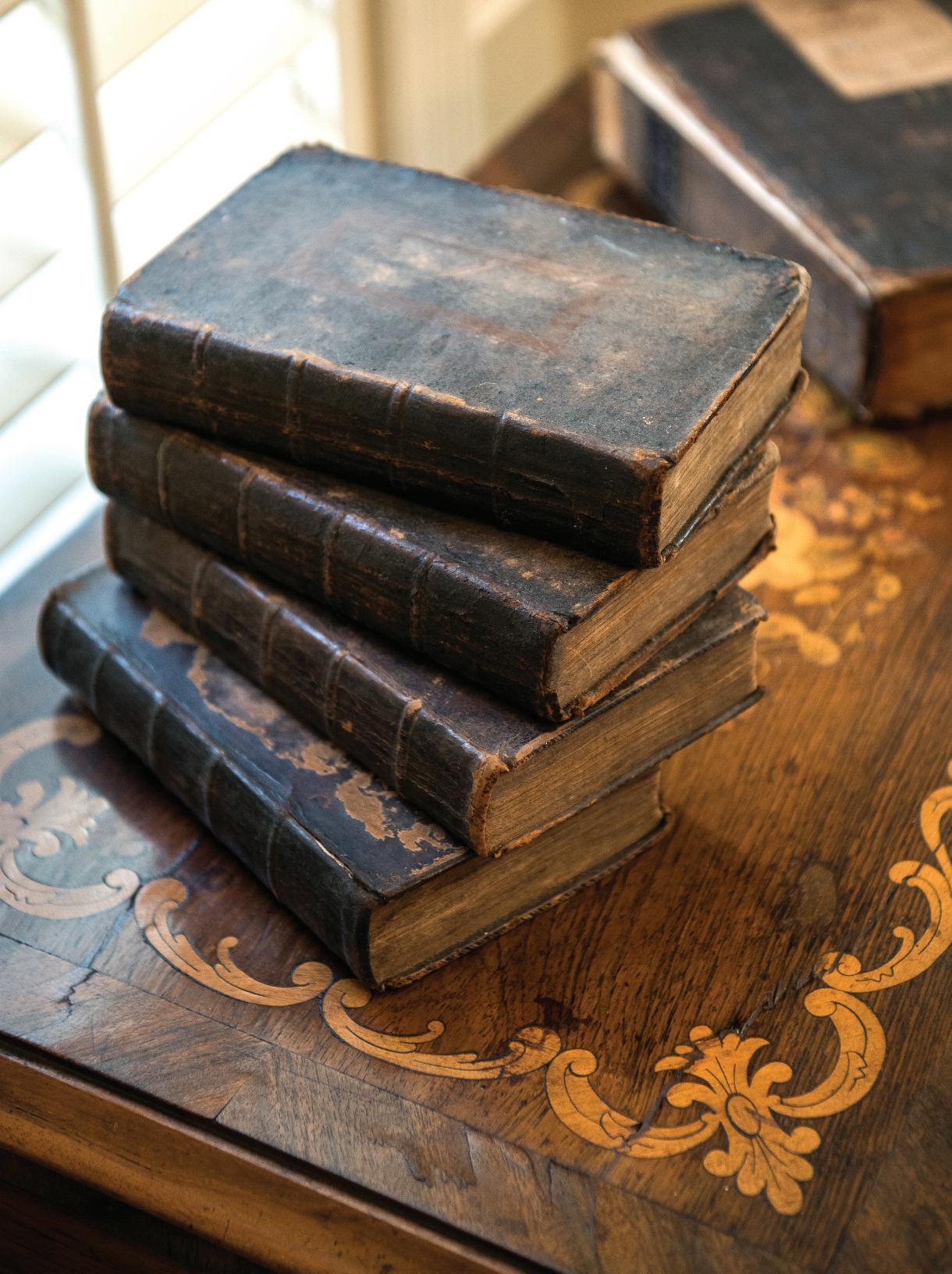
How a 400-plus year old Bible found it’s way from Queen Elizabeth’s print shop to the Mississippi Delta

BY REBEKKAH ARANT • PHOTOGRAPHY BY RORY DOYLE

FAMILIES GATHERING THIS HOLIDAY SEASON WILL LIKELY FIND GREAT JOY AS NEW STORIES ARE TOLD AND THE OLD ONES ARE RECOUNTED. These remembrances may be shared around a greatgrandmother’s cherished antique dining table while enjoying decades-old family recipes served on dishes handed down from generation to generation. There is a real comfort that comes from the familiar faces and surroundings we’ve grown to love over the years. Happy memories are made in a setting, and the objects people are surrounded by reflect a lot about those to whom they belong. It’s the stories of objects like these that attract collector Dr. Andrew Jones.
A Cleveland resident and retired Delta State University professor, Dr. Jones has been an avid collector for years. A collector by nature, Jones recalls gathering rocks and simple things that didn’t have much value when he was a child; they just sparked his interest. The first item that truly inspired his hobby was a coffee pot given to his mother by a beloved teacher; his mother then passed the coffee pot down to him. Now his collections range from antique furniture to cut glass to artwork. But, perhaps, it’s his gathering of old Bibles and religious texts that is the most fascinating.
Made up of more than sixteen Bibles and various other books including an Isaac Watts songbook and a history of baptism, this collection showcases books that Jones has picked up over the years for their unique qualities. The book that began the collection was his student Bible from Mississippi College. Jones was a speech major
Jones attaches personal notes detailing the uniqueness of each volume.
at Mississippi College, and he quickly added to the collection when the library there had to discard some of its books. He explains, “They were stacked up on the third floor. Well, as it turned out, in 1949 the speech department was started, and they put them on the third floor of the library. So I was around those books, and they were having to move them and throw them away, so one or two of them I picked up there.”
He added a notable volume to his collection in 1965. While teaching at Mississippi University for Women, he received a flyer in the mail advertising used books and saw an old Bible for sale. He thought it looked interesting and bought it for a sum of around thirty-five dollars. That particular Bible turned out to be a 1599 edition of the Geneva Bible imprinted by Queen Elizabeth I’s publisher Christopher Barker. Elizabeth I reestablished England as a Protestant nation, and this version of the Bible flourished in her reign, influencing such writers as William Shakespeare, John Bunyan, and John Milton.
However, it wasn’t until 2016 when Jones read an article in The Clarion-Ledger about another copy of the same Bible that he truly realized what he had. The article told the story of a history major at

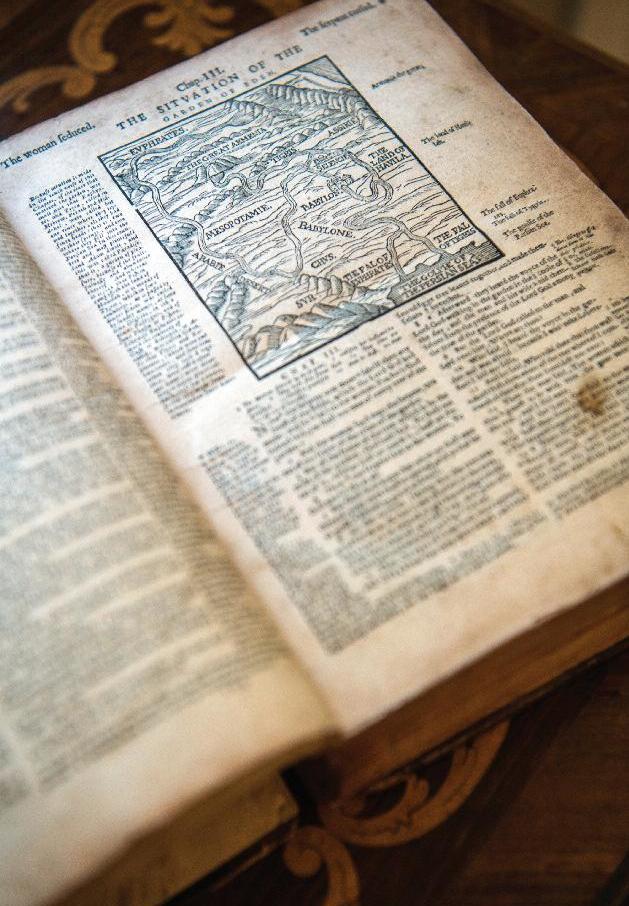
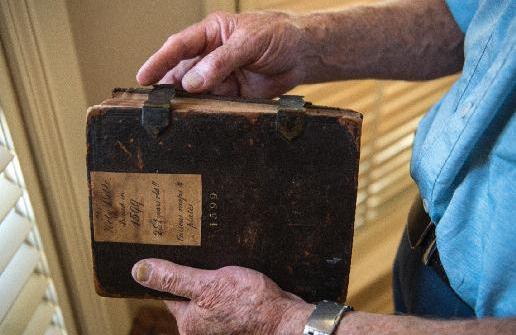

Printed in 1599, this rare Bible contains intricate woodcut illustrations and is closed with metal clasps.
Dr. Jones’s Bible is similar to one known to have been carried to North America by the Pilgrims aboard the Mayflower.

Lewis and Clark College in Oregon who found the Bible by chance when going through historical documents in the school’s library. The Bible described in the article seemed immediately familiar to Jones, so he went to his collection and confirmed that it was the same book. He notes, “It means more now that somebody else has one too. It’s not just a castaway.” Over four hundred years old, the Bible remains in good A page from the Geneva condition, complete with metal clasps, Bible, showing the use of the and is worth well more than he paid letter “f” in place of “s”. for it.
Other significant works in the collection are a complete fourvolume Douay Old Testament published in 1796 and an 1861 New Testament printed with every other page blank so that readers could take notes. The Douay is a Catholic translation of the Latin Bible and serves as the foundation for most modern Catholic versions. Although Jones doesn’t plan to learn Greek or Hebrew, he has copies of the Bible in both languages. He found the Hebrew version particularly interesting as the Hebrew language is written and read right to left.
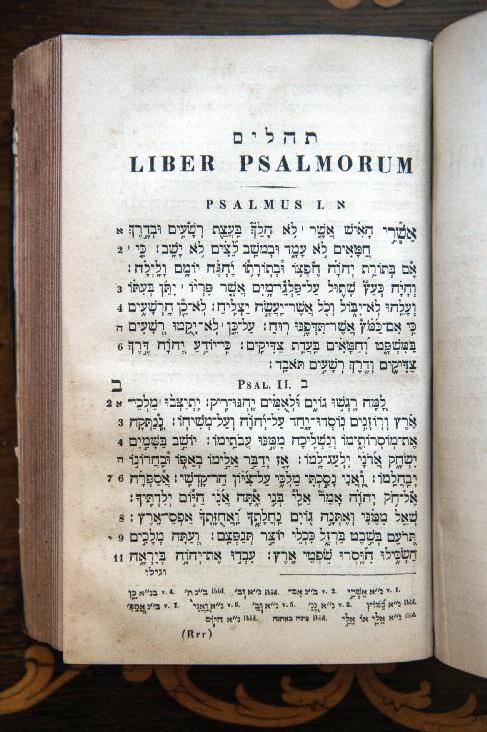
Jones’s collection includes a Hebrew Bible that was a library discard; interestingly, Hebrew texts are written and read right to left.
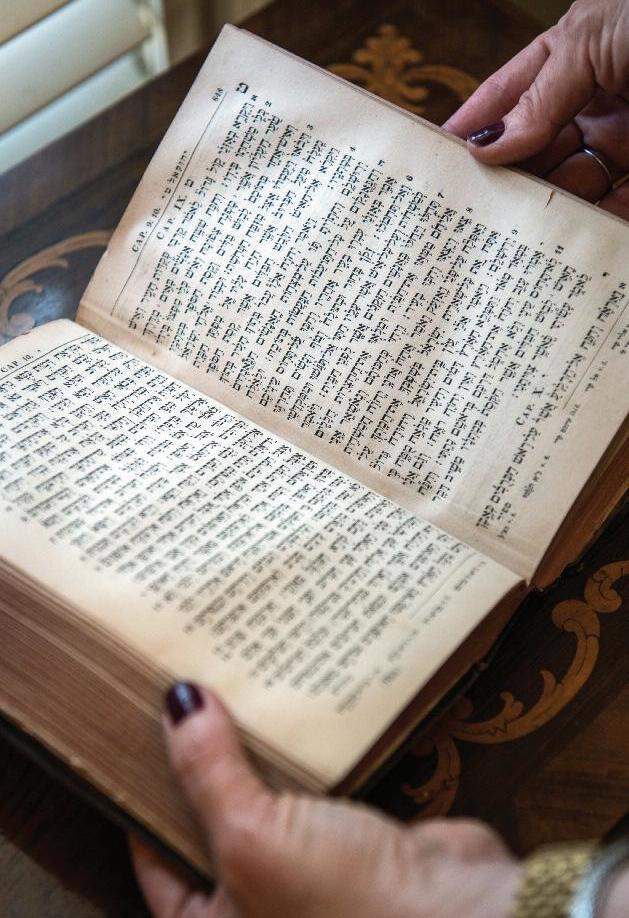
Also in the collection is a Bible printed in 1847 and distributed by the Young Men’s Bible Society of Cincinnati, a group that placed Bibles in hotels before the Gideons. This is one of Jones’s favorites because of its background. He says, “Somebody lifted it, and it ended up in a used book store, so that is the reason I got it, because of the uniqueness of it.”
A few of the books hold particular meaning for Jones. A small Bible made with a mother-of-pearl cover was a gift from his wife. Appreciating her husband’s interest in old Bibles and in items made of mother-of-pearl, Jones’s wife knew it would be the perfect fit for his collections. A well-worn black volume in the collection was also a gift. He explains, “my mother-in-law bought that and gave it to my wife, and my wife has drawn a line through her name and put my daughter’s name in it, so they are passing it on.” Jones says the Bible “will mean something special” to his daughter.
Although Jones is not actively adding to this collection, he suggests that he would pick up a piece “if it is really a bargain and not like anything” he has. He frequents used book stores and consignment shops, so the possibility of a new addition is not unlikely. As for the future of the collection, Dr. Jones hopes that it will be “preserved so that other people could see them because there is a good bit of history.” And it’s the history of the items that fascinates him. Jones has an uncanny ability as a storyteller and can recount the history and details of each piece with a stunning familiarity that captivates the listener. He points out, “Stories come natural after you work to find out about it. It sticks with you and you remember.” He goes on to say, “Where I got it, who owned it, has a lot to do with the value that I place with it.”
Jones proves that the value of a collection is found in the collector’s fascination and enjoyment of the objects. He encourages others who are interested in collecting to choose “something that hits you and you like it” and points out that “you have to be aware that you may collect something and put a good bit of money in it that becomes worthless,” monetarily speaking. It is for this reason that he collects pieces that he finds meaningful or unique rather than things that simply have an extrinsic value.
Treasured items are on full display in this season of traditions, and their stories are waiting to be shared. Jones explains that the inclination to cherish family heirlooms is fueled by “the feeling you’d like to hold on to a little something you’ve been around.” At Jones’s house, his Bible collection will “take a backseat” during the holidays because “the Christmas tree goes right in front of the fireplace, and it will have 125 Gorham snowflakes on it” that he has collected over the years. Through these collections, Jones has learned about his interests and his family history and believes that others can use collecting as a way to learn, “especially if you are collecting stuff that was in your family.”

